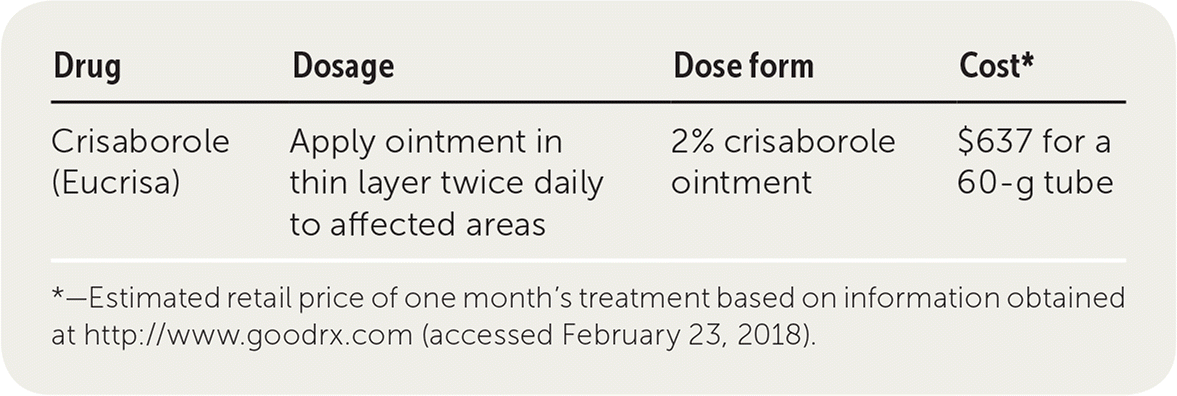
Am Fam Physician. 2018;98(6):379-380
Author disclosure: No relevant financial affiliations.
Crisaborole (Eucrisa) is a topical nonsteroid treatment for mild to moderate atopic dermatitis in children two years and older.1 It is a phosphodiesterase-4 inhibitor, although its mechanism of action for atopic dermatitis is unknown.

| Drug | Dosage | Dose form | Cost* |
|---|---|---|---|
| Crisaborole (Eucrisa) | Apply ointment in thin layer twice daily to affected areas | 2% crisaborole ointment | $637 for a 60-g tube |
Safety
Studies have shown crisaborole to be safe with few adverse effects. The three most common adverse effects are application site infection (1.2%), burning or stinging with application (2.3%), and worsening dermatitis (3.1%).2 A year-long study of 517 children and adults did not report adverse effects commonly associated with topical corticosteroid treatment, such as skin thinning, striae, or adrenal axis suppression.3 Hypersensitivity reactions, such as contact urticaria, rarely occur.1 There are no available data on the safety of crisaborole in women who are pregnant or breastfeeding, children younger than two years, or adults 65 years and older.
Tolerability
Crisaborole is well tolerated by most patients. Only 1.7% of patients will discontinue treatment because of adverse effects.3
Effectiveness
Crisaborole improves lesion clearing and pruritus in patients with atopic dermatitis to a greater extent than emollient treatment alone.2 In two studies with a total of 1,522 patients who had mild to moderate atopic dermatitis, significantly more patients treated with crisaborole achieved results of “clear” or “almost clear” as evaluated by investigators, compared with treatment using only emollient ointment (32.8% vs. 25.4% in study 1, and 31.4% vs. 18% in study 2).2 These results reflect at least a two-point improvement in lesion clearing on a five-point assessment, which is clinically meaningful. One additional patient will respond for every eight to 14 patients treated with crisaborole compared with emollient ointment alone. Pruritus responds in a few days to use of crisaborole or emollient ointment, but more patients will experience further clearing with crisaborole after about one week of treatment. There are no data on long-term effectiveness because studies have lasted for only 28 days. Crisaborole has not been compared directly with topical corticosteroids or other treatments for atopic dermatitis.
Price
A one-month supply of crisaborole (one 60-g tube) is approximately $637. This is substantially more expensive than generic topical corticosteroids such as triamcinolone, which costs about $6 for a 30-day supply (one 15-g tube). Crisaborole may require prior authorization for insurance coverage, including documented treatment failure with other medications.
Simplicity
Patients should apply a thin layer of crisaborole to the affected area twice daily. The dosing and patient directions are similar to those of already available products, although some topical corticosteroids can be used once daily.
Bottom Line
Crisaborole has been shown to be effective in about one-third of patients who use it, but it is much more expensive than other available products. Although crisaborole is a safe option for patients in whom topical corticosteroids are considered risky (e.g., children at least two years of age), it should not be routinely considered until long-term effectiveness and safety data become available.
